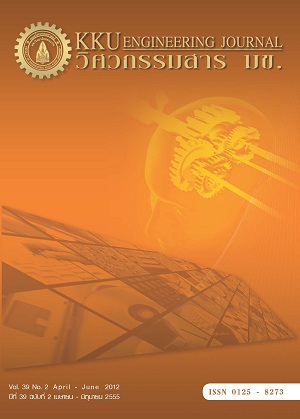Using lime and fly ash replaced OPC in lightweight concrete with aluminum dust and pure aluminum
Main Article Content
Abstract
This research investigated possibility for replaced ordinary Portland cement, Type I (OPC) using hydrated lime and fly ash in the production of lightweight concrete with aluminum dust from aluminium melting factory and pure aluminum. The ratio of hydrated lime and fly ash of 35:65 by weight replaced OPC at the levels of 0, 25, 50 and 75 % wt. The aluminium waste at 20 %wt. and pure aluminum at 0.5 %wt. were added. The ratio of cementitiousmaterials (OPC, hydrated lime and fly ash) and sand of 1:1 by weight was used. There was replacement of OPCusing 10 wt. % of quick lime. Experimental results showed that replaced level of hydrated lime and fly ash increased,compressive strength and bulk density decreased. The lightweight concrete containing hydrated lime and fly ashat levels of 75 %wt. and pure aluminium had compressive strength and bulk density of 51.20 kg/cm.2 and 785kg./m.3, respectively. When quick lime was replaced OPC, the compressive strength and bulk density decreased to37.40 kg/cm.2 and 733 kg./m.3, respectively. In addition, the thermal conductivity of lightweight concrete was 0.21W/m-K. In adition, the lightweight concrete containing hydrated lime and fly ash at levels of 75 %wt. and aluminiumdust had compressive strength and bulk density of 76.45 kg/cm.2 and 985 kg./m.3, respectively. When quick limewas replaced OPC, the compressive strength and bulk density decreased to 42.7 kg/cm.2 and 788 kg./m.3, respectively.In addition, the thermal conductivity of lightweight concrete was 0.24 W/m-K. Strength and density of thesample met the requirement of Thai Industrial Standard TIS 1505-2541 class 4 for autoclaved aerated.
Keywords : Lightweight concrete, Aluminum dust, Compressive strength, Thermal conductivity
Article Details
This work is licensed under a Creative Commons Attribution-NonCommercial-NoDerivatives 4.0 International License.



